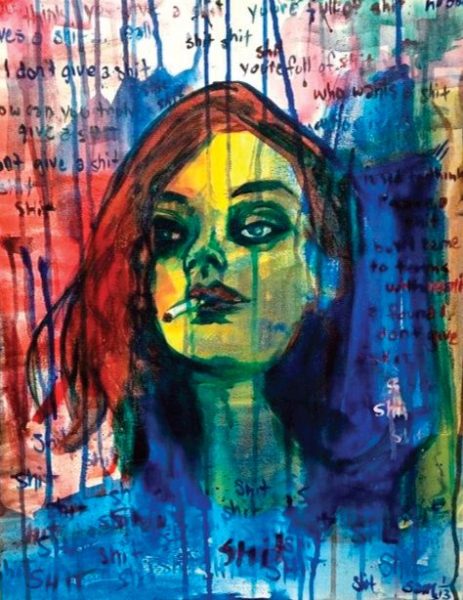What inspired the idea for “How Many Lives”?
On Fridays, a group of writers compose 140 character stories on Twitter called Friday Phrases with the hashtag #FP. I had a random thought about a person’s life flashing before their eyes, but I decided this person saw not her life but other people’s lives. The Tweet one particular Friday was this: “When her car went over the cliff, the lives flashing before Jenny’s eyes weren’t hers. She wondered how many lives can one person have? #FP” These 140 character stories sometimes get under my skin. I kept asking why she was seeing other people’s lives and whose lives was she seeing. The inspiration was simply engaging a random thought for the Friday Phrase and then letting it fester in my psyche until it begged to be written as a full story.
Have you had many near death experiences?
I had a near death experience in my early twenties that still haunts me. In the wee hours of the morning, a friend and I took a drive in his sports car on narrow roads outside Lexington, KY, something he and I occasionally did. He liked how the car hugged the curves, and he liked speed. There’s only one straight stretch, and it was about three-quarters of a mile with a small three or four degree angle in the final quarter mile. That night I saw the speedometer hit 95 mph, and I had a feeling that I needed my seatbelt on. Within seconds of the click of the seatbelt, the car failed to make this small angle and the sports car went through a post and three strands of barbed wire into a cornfield. Had I not put my seatbelt on, I would have gone through the windshield and died. I’ve always known this. I have a short story called “A Perfect Life” which fictionalizes this accident. My life didn’t flash before my eyes, but I do believe that some force, maybe God or the gods, wasn’t ready for me to die that night. I think there is always drama in death, whether it’s a violent death or a quiet one, and always a story wanting to be told.
One of the things I admire about this piece is the intersecting flashbacks and how the language interacts with the different lives and scenes and memories. Where did this idea arise?
Would you believe me if I said the idea was inadvertent? I think seeing light coming through the windshield and a similar kind of light in the delivery room made the initial shift feel seamless, like a movie camera zooming into the light during the accident and then zooming out into the delivery room. It felt right, but I couldn’t make every shift visual, so I focused on the language. My hope was that the language would ease the disjointedness between the memories. My fear was that the transition would feel like something I pulled from a bag of tricks, or a bit of foolery. To overcome the risk of foolery, I decided to make each memory as if the language was pulled from a separate story, just as each is a separate life. In the end, I think it worked.
What are you working on now and who are your favorite writers? What authors have inspired you?
Last month, August, 2014, I finished the first draft of a novel called The Short Straw about three sixteen year old best friends in a small Kentucky town whose lives are disrupted by the new kid in town. The first line in the novel refers to the new kid an interloper, a word I first read in Stephen King’s The Gunslinger . In The Gunslinger, Roland Deschain is the interloper, and he kills most of the citizens of Tull. Likewise, the interloper in The Short Straw brings a special form of chaos to the lives of these friends. While I wait to begin the editing process on The Short Straw next year, I’m focusing on several new short stories and editing drafts of older stories.
I try to not pay attention to genre when I write, and this parallels what I read. My favorite writers are Stephen King, John Irving, Neil Gaiman, Kurt Vonnegut, Larry McMurtry, J.R.R. Tolkien, George R.R. Martin, E.B. White, and Ann Patchett. It’s not a short list, I know, but each author has given me different insight not just into the world, but also into writing. The common theme that brings them into my world is that they are great story tellers and use language beautifully. At some point, these writers have inspired me as a writer.
You write with a pseudonym and your bio mentions how you must protect your identity. Is there anything you would like to elaborate on?
I have a 50-hour-a-week regular job that I work my writing around. On my blog, I refer to the person that performs this job as “the other-me.” I refer to myself as “the writer-me.” When I took on the pseudonym, the purpose was to create separation between my two very different lives. As the writer-me, I wanted to have the freedom to write whatever I wanted without the people that know the other-me looking over my shoulder. To be perfectly blunt, the writer-me could negatively impact the other-me’s career. It’s not that my writing or ideas are abhorrent, they’re just different than the persona of the other-me. So until the writer-me can financially shed the other-me, never shall the twain meet.



 The core workshop of SmokeLong Fitness is all in writing, so you can take part from anywhere at anytime. We are excited about creating a supportive, consistent and structured environment for flash writers to work on their craft in a community. We are thrilled and proud to say that our workshop participants have won, placed, or been listed in every major flash competition. Community works.
The core workshop of SmokeLong Fitness is all in writing, so you can take part from anywhere at anytime. We are excited about creating a supportive, consistent and structured environment for flash writers to work on their craft in a community. We are thrilled and proud to say that our workshop participants have won, placed, or been listed in every major flash competition. Community works.